Biking With Bison in Poland’s Bialowieza Forest
Exploring one of Europe’s last primeval forests, Steve White has a misty morning encounter with the heaviest animal on the continent.
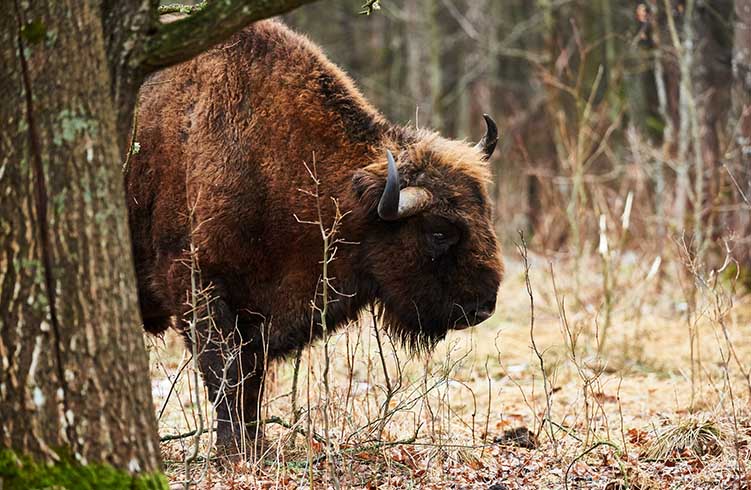 Photo © Getty Images / LuCaAr
Photo © Getty Images / LuCaAr
- On the trail of wisent (European bison)
- Conservation and controversy in Bialowieza
- Zubra in the mist
- Trip Notes
In Poland’s primeval forest, the ancient beasts of Europe are walking again. Here, the likes of wolves and lynx, returned from the edge of regional extinction, prowl on the trail of chamois and mouflon. So goes the promise of rewilding: a winding of the clock back to a time before man messed with nature.
On the trail of wisent (European bison)
I’ve come to the small Polish village of Bialowieza (Be-ow-vish-ka is as close as English gets), no more than a rifle shot from the Belarus border. Long a hunting reserve by royal decree, today Bialowieza Forest is a transboundary World Heritage Site with around 30% of the world’s population of wisent, the European forest bison.
Standing up to 6.5ft (2m) at the shoulder, the wisent, or zubra as they are called in Polish, is a taller, slighter, lighter cousin to the familiar buffalo species of North America. “Lighter” is relative: big males can still tip the scales at more than 2,200lbs (1,000kg).
The wisent disappeared entirely from the wild in the 1920s, but are now coming back, largely thanks to a domesticated herd in Bialowieza’s reserve. Pioneering environmental organization Rewilding Europe sees them as the area’s keystone species.
To get a sense of the area, I spend my first afternoon on a rented bike, riding out of the village and onto freely accessible forest trails. Long and straight, they are ideal for spotting animals. I watch a fox trotting unconcernedly ahead long before he saw or heard me – then it’s my turn to be surprised, as a large boar lumbers out of the bushes in front of me, stops transfixed for a second, then lurches back from where it came.
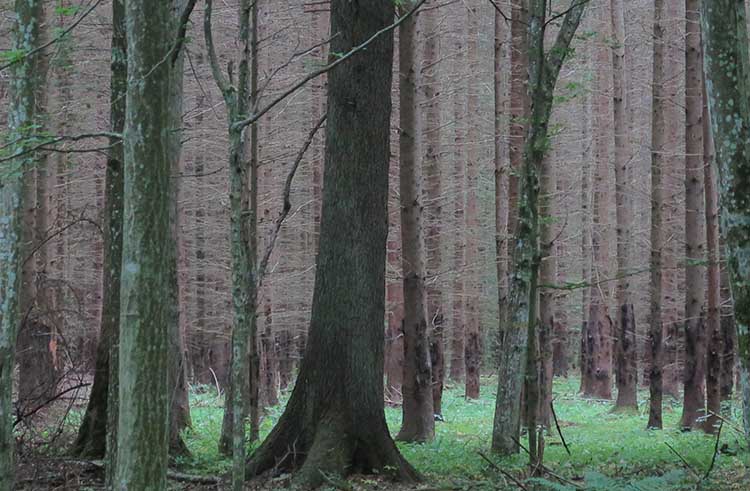
Conservation and controversy in Bialowieza
The next morning, Joanna Smerczyńska, a guide with wildlife tour experts Wild Poland, is waiting for me at the front gate of Bialowieza’s Palace Park. A local, she has returned to the area after studying in the environmental field, to take up her abiding interest in the bison and their Bialowieza habitat.
She drives us past the formal gardens to a stretch of open meadow, where we walk a track down towards the forest. Though only just past nine, it’s too late for the bison, who slip out from the trees to graze in dawn’s half-light. Instead, she introduces me to the meadow’s birds: various larks, the corn bunting, and the corncrake, now rare elsewhere.
We enter the tranquil forest and began to pick our way past oak, linden, and hornbeam, along with stands of Norwegian spruce. It’s beautiful, but subtle evidence of man’s long reach is everywhere. Many of the spruce, Smerczyńska said, have been planted commercially.
She shows me trees drilled out for traditional bee-keeping, then points out a rare, white-backed woodpecker at work on a dead spruce. She tells me how this species favors decaying wood for its nest holes This tree, dozens of feet tall, may remaining standing for decades, hosting generations of birds.
Bark beetles periodically attack the spruce, and in 2016 the then-government began felling and removing infested trees, saying they posed a danger to tourists. Environmentalists were alarmed at the scale of logging. They countered that dead trees should simply be left to rot where they fell, not be towed away and sold. Logging was ceased by order of the EU Court of Justice, but the battle over the forest continues.
It’s a complicated issue. What is clear is that this area, protected land for centuries, has seen use and misuse over and over. In WWII, German troops billeted in the area shot large numbers of zubra in the forest, putting the species in peril. Sadly, not only bison suffered in those dark times, and Smerczyńska mentions how mass graves with human remains have also been found among the trees.
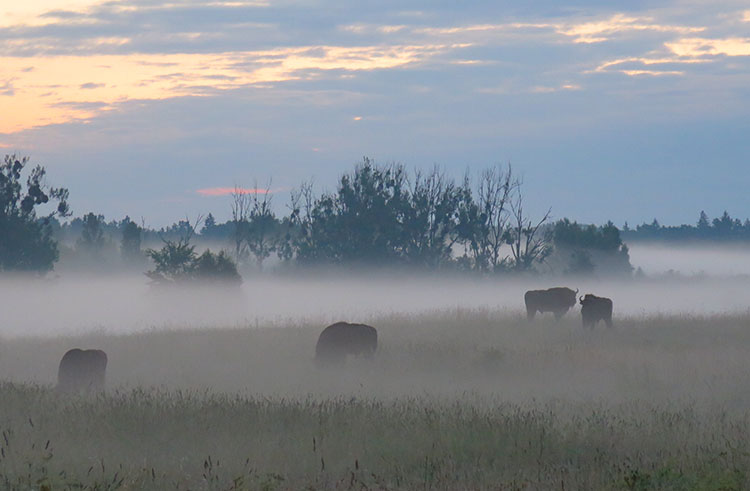
Zubra in the mist
Now that I have the lay of the land, I set my alarm for 5am, and ride out the next morning into the frigid dark. Mist lays thick, and all is hauntingly still, except for the calls of a few early larks.
With the cold seeping up my legs and worming under my inadequate jacket, I head for a track that parallels the forest’s edge, slightly higher than the fields. Halfway along is a police post I’ve been told is a prime bison spot.
I ride several hundred meters to the track’s end, seeing only a wall of mist, then turn back as a watery sun began to slide up behind the trees. I’m again close to the police post when I see several humped shapes in the grey, perhaps 65ft (20m) from the track.
I edge closer until they are unmistakable. Zubra. A dozen or so SUV-sized beasts, grunting contentedly as they pull at the long grass. They appear to me like stout ships, gliding through a barely rippling sea.
Then, at some unspoken signal, whether spooked by me or just by the dissipating mist, the spell is broken, and they drift back through the meadow into the trees and are gone.
Trip notes
When to go
Spring is ideal, with the meadows busy with birds. Bring binoculars and warm layers for chilly early starts.
Getting there
From Warsaw you can take a train to Bialystok, then a bus to the quiet village of Bialowieza, at the southern edge of the protected area.
Where to stay
Staying in Bialowieza itself puts you close enough to walk or cycle to the park for early morning visits. The pensions and hotels have a robust Central European look: wood throughout, with a distinct hunting vibe. Think Austrian chalets with fewer frills and more trophy heads. Many places have bikes for hire for a few dollars a day. With your own vehicle, you can consider staying in the bigger town of Hajnowka, a 15-minute drive away.
Listen to The World Nomads Travel Podcast - Poland
Hear more from our authors about the Bialowieza Forest, tracing family history in Poland's off-the-beaten-path cities and towns, and why Poland is emerging as a travel destination.
Related articles
Simple and flexible travel insurance
You can buy at home or while traveling, and claim online from anywhere in the world. With 150+ adventure activities covered and 24/7 emergency assistance.
Get a quote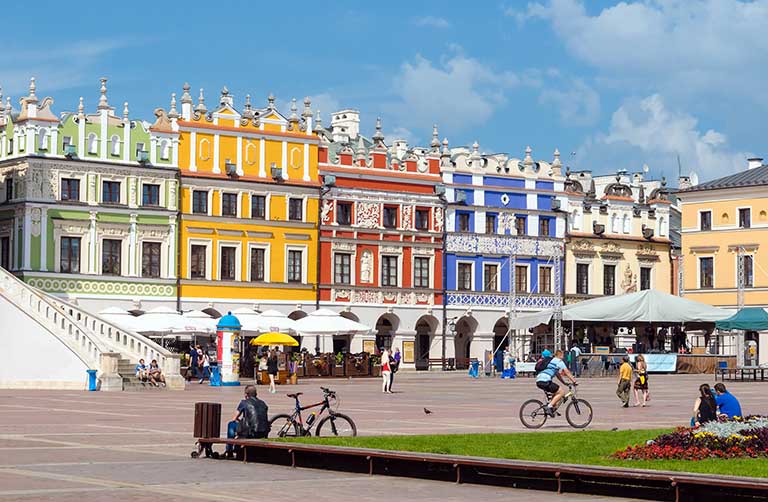

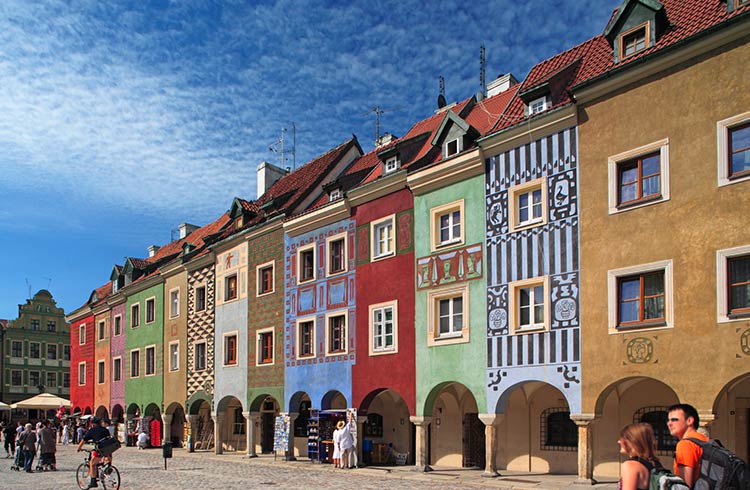
2 Comments
Hi Steve,
Lovely article. I love this part of Poland. It's still relatively unspoilt and it has an incredible atmosphere.
Just a little correction...we call those animals Zubr (singular) and Zubry (plural). Zubra is a variation of the word ...I know, Polish is a complicated language ;-)
Feeding my knowledge about Bison, the woods of Bialowieza and its' environs from this remarkable publication by Steve White has lifted my day as well as embracing nature, culture and heritage. Truly, this will bring about positive climate change if our animals and games are well preserve and nurtured. Come to think of it, drastic prevention of deforestation could bring about peace and unity amongst countries. Wow...Poland must be a beautiful place.